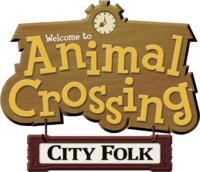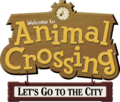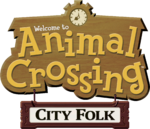Animal Crossing: City Folk
| ||||||
 North American game cover | ||||||
| Developer(s) | Nintendo EAD[1] | |||||
|---|---|---|---|---|---|---|
| Publisher(s) | Nintendo[1] | |||||
| Director(s) | Hisashi Nogami | |||||
| Platform(s) | Wii | |||||
| Release date(s) | ||||||
| Genre(s) | Simulation | |||||
| Language(s) | ||||||
| Modes | Single-player Multiplayer (1–4 player online) | |||||
| Ratings | ||||||
| Media | Wii Optical Disc | |||||
| Input methods |
Wii Remote, Nunchuk, Wii Speak, USB keyboard, Nintendo DS | |||||
Animal Crossing: City Folk,[nb 1] known in Europe and Oceania as Animal Crossing: Let's Go to the City,[nb 2] is a simulation game for the Wii released in 2008. It is the third main installment in the Animal Crossing series outside Japan. The game was released on November 16, 2008 in North America, the first time a game in the series was released in another country before Japan. In Japan, Europe, and Australia, the game was released on November 20, 2008, December 5, 2008, and December 4, 2008, respectively. The title includes a variety of changes and additions to the Animal Crossing formula, including the ability to travel to the city.
City Folk is also the first Animal Crossing title to be released with separate American and European localizations for French (France and Quebec) and Spanish (Spain and Latin America).[2] Previous titles released in the Americas were only available in English.
Like most Wii games, City Folk originally had an MSRP of $49.99, but was later dropped to $19.99, when it was re-released with the first Nintendo Select titles in 2011.[3] Some editions of City Folk were bundled with the Wii Speak peripheral, but this stopped after the product's discontinuation. These editions of City Folk originally had an MSRP of $69.99, but was later dropped to $34.99-$49.99 (all prices USD).[citation needed]
New features[edit]
The city[edit]
Animal Crossing: City Folk features a newly accessible location called the city. The city houses most of the characters that, in previous games, were considered special visitors. These include Gracie and Labelle, who work at GracieGrace, Redd who sells art and furniture, Harriet, who works at Shampoodle and does hairstyles, Dr. Shrunk and Frillard, who give the player emotions at The Marquee, Lyle, who works at the Happy Room Academy for home evaluations, Katrina, who tells the player their fortune, Lloid, who operates the Auction House, Resetti and Don, who work at Resetti Surveillance Center, Kicks, who can change the player's shoes, and Phineas, who sells balloons and toys. The City is accessible via Kapp'n's bus and is open all hours of the day. Most of the shops close at 9 PM daily, with the exception of Redd's Store and The Resetti Surveillance Center. The city also introduces new characters such as Phineas and Kicks, into the franchise.
Moving[edit]
The player has two options when they move in: to start new or transfer their character from Animal Crossing: Wild World. This only moves over the character and their appearance; any other data, including their house, progress, and items from Wild World, are not carried over. The player gets a choice of four houses to move into at the start of the game.
Wi-Fi[edit]
City Folk featured Wi-Fi capabilities, which were earlier implemented in the previous game, Wild World. This feature gave the player access to other towns, enabled them to communicate with friends' towns with letters, and also provided players with special items sent from time to time from Nintendo, many of which referenced some of the company's best-selling games. Optionally, players could make use of voice chat via Wii Speak. The game's Wi-Fi capabilities also allowed players to experience the Mysterious Cat, an event that enabled a visit from Blanca.
On May 20, 2014, Nintendo officially shut down the Nintendo Wi-Fi Connection service, ending the Wi-Fi capabilities found in City Folk.[4] However, fans have made custom servers to access the Wi-Fi capabilities again in an unofficial capacity.[5]
Miscellaneous[edit]
- New fish (pike, neon tetra, surgeonfish, butterfly fish, Napoleonfish, lobster, moray eel, and ray).
- New bugs (Raja Brooke, giant petaltail, walking leaf, violin beetle, cyclommatus, golden stag, and centipede). The diving beetle, miyama stag, and bagworm also returned from Animal Crossing.
- New events, notably Festivale and Bunny Day. Halloween, Harvest Festival and Toy Day returned after being absent in Wild World.
- Tools and other handheld items can now be switched by pressing left or right on the d-pad. Additionally, pressing up on the d-pad allows the player to look at the sky.
- Silver tools were added, which have better attributes than standard tools, but are generally easier to obtain and less powerful than golden tools.
- Mii Masks can be obtained at Shampoodle.
- The town fund was introduced; this replaced Boondox donations from Wild World. Donating to the fund allows an extra bridge, a fountain, and either a windmill or lighthouse to be built. The player can throw an axe into the fountain to summon Serena.
- New villagers and special characters were added, and many that were absent in Wild World returned.
- The player can create Pro designs at Able Sisters. These allow separate patterns for the left sleeve, right sleeve, front, and back of clothing items.
- After obtaining Nookington's, Tom Nook will periodically ask players what they look for in their shopping experience. This can result in the store downgrading to a previous version (Nookway or Nook 'n' Go). Online play is also no longer required to obtain Nookington's.
- Players now have their own house instead of sharing one as in Wild World. If they pay off their house completely, a flag will be displayed outside.
- The player may be asked to play hide-and-seek or fish out a key for a villager.
Characters[edit]
Special characters[edit]
Animal Crossing: City Folk introduces eight new special characters, while seven old ones return after being absent in Wild World.
New special characters[edit]
Kicks
Shoe shining
Returning special characters[edit]
The following special characters return from Doubutsu no Mori e+ after being absent from Animal Crossing: Wild World.
Chip
Fishing Tourney hostDon Resetti
Appears after the player resets without saving (rarely)Lloid
Auctioneer
Villagers[edit]
There are a total of 210 villagers in City Folk, which is 60 more than Animal Crossing: Wild World. 18 new villagers have been added, and 42 have returned after being absent from Wild World.
New villagers[edit]
Returning villagers[edit]
42 villagers return from Doubutsu no Mori, Doubutsu no Mori+, Animal Crossing, and the Japan-exclusive Doubutsu no Mori e+. 14 villagers (marked ![]() below) initially only appeared in the latter game and receive localized names for the first time. Two of the returning villagers have their personalities changed.
below) initially only appeared in the latter game and receive localized names for the first time. Two of the returning villagers have their personalities changed.
Development and unveiling[edit]
The conception of Animal Crossing: City Folk began prior to the release of Animal Crossing: Wild World, and it was confirmed that an Animal Crossing title for the Wii, then codenamed Revolution, was in development. Katsuya Eguchi, the producer of both titles, suggested that the two titles may be able to link up to one another at E3 2005.[6] In 2006, Eguchi confirmed that City Folk was still just a concept and very little work had been completed. His time was being consumed by research and development of the Wii console.[7] The Animal Crossing team explored ways to involve the Wii Remote. They planned to allow players to use tools, such as the axe, shovel, and fishing rod. They also explored the use of WiiConnect24 in the hopes that a player could visit a friend's town even when they were not playing. The friend could then leave letters or gifts. Additionally, they planned to use the Wi-Fi Connection to allow simultaneous play. At this point, however, the title was still not playable.[8]
In early 2007, Nintendo of Japan unveiled its video game lineup for the coming year; it included "Doubutsu no Mori".[9] Having finished the Mii Channel for Wii, Animal Crossing: Wild World director Hisashi Nogami joined the Animal Crossing team once more.[10] Later that year, Edge Magazine reported that a trusted source confirmed that City Folk would be a massively multiplayer online game. The publication declined to name the source.[11] Nintendo failed to release the title in 2007. Online publication IGN Wii predicted that the title would arrive in 2008.[12]
At E3 2008, Reggie Fils-Aime unveiled the title in playable form under the name Animal Crossing: City Folk. It was released in November 2008.[13]
Reception[edit]
Initial editorial previews of the title from IGN and GameSpy indicate that, as with the title's predecessor, Animal Crossing: Wild World, "Nintendo has made very few changes to the title and that people, who played all the past Animal Crossing games, will not find much in City Folk, although the game was still fun and might appeal to newcomers." IGN gave City Folk a 7.5/10 rating.[14] GameSpot gave a positive preview of the title, noting the charm of the game, but gave the game a 7.5/10 rating.[15]
Related media[edit]
Animal Crossing: City Folk received two soundtrack CDs: Machi e Ikou yo Doubutsu no Mori ~Mori no Ongakukai~ in Japan and Animal Crossing: Your Favourite Songs - Original Soundtrack in Europe.
A one-shot manga based on City Folk, Machi e Ikō yo Doubutsu no Mori: Tanpopo Murada Yori, was released in 2010 in Japan.
Gallery[edit]
A player fishing
A player exploring the city
A group of players in a house
A player exiting the bus
A player in the fish exhibit of the museum
A player witnessing a balloon fly by
Entering the checkpoint
Leaving the checkpoint
Names in other languages[edit]
| 街へいこうよ どうぶつの森 Machi e Ikou Yo Doubutsu no Mori |
Animal Forest: Let's Go to The City | |
| 타운으로 놀러가요 동물의 숲 Taun-Wuro Nolleogayo Dongmur-Ui Sup |
Animal Forest: Let's Go to The City | |
| Animal Crossing: Let's Go To The City | - | |
| Animal Crossing: Let's Go To The City | - | |
| Animal Crossing: City Folk | - | |
| Animal Crossing: Let's Go To The City | - | |
| Animal Crossing: City Folk | - | |
| Animal Crossing: Let's Go To The City | - | |
External links[edit]
Notes[edit]
References[edit]
- ↑ 1.0 1.1 1.2 Nintendo of America. "Animal Crossing: City Folk". nintendo.com. Archived from the original on December 8, 2008.
- ↑ Animal Crossing: City Folk - Comparing Spanish localizations (LATAM & EU), YouTube.
- ↑ https://www.nintendo.com/wii/console/nintendoselects
- ↑ Nintendo - Service Update: Online Gameplay
- ↑ https://wiimmfi.de/
- ↑ Casamassina, Matt (5-19-2005). E3 2005: Animal Crossing Revolution. IGN Wii. Accessed on 7-22-2008.
- ↑ Harris, Craig (3-24-2006). GDC 06: Chat with Eguchi. IGN Wii. Accessed 7-22-08.
- ↑ Casamassina, Matt (5-18-2006). Interview: Wii Sports. IGN Wii. Accessed 7-22-08.
- ↑ Casamassina, Matt (2-22-07). Nintendo Lists Major Wii Games for 2007. IGN Wii. Accessed 7-22-08.
- ↑ Casamassina, Matt (7-12-07). E3 2007: Animal Crossing Update. IGN Wii. Accessed 7-22-08.
- ↑ Casamassina, Matt (10-24-07). Rumor: MMO Animal Crossing. IGN Wii. Accessed 7-22-08.
- ↑ Bozon, Mark and Casamassina, Matt (1-18-08). IGN Wii's Preview 2008 p.9. IGN Wii. Accessed 7-22-08
- ↑ DeVries, Jack (7-15-08). E3 2008: Animal Crossing Coming to Wii. IGN Wii. Accessed 7-22-08.
- ↑ http://wii.ign.com/articles/890/890136p1.html E3 2008: Animal Crossing: City Folk Hands-on
- ↑ Kevin Vanord. "E3 2008: Animal Crossing: City Folks Hands-On". GameSpot.
| This article is a stub. You can help Nookipedia by expanding it. |
| Animal Crossing: City Folk | ||||||||||||||||||||||
|---|---|---|---|---|---|---|---|---|---|---|---|---|---|---|---|---|---|---|---|---|---|---|
| ||||||||||||||||||||||
| Animal Crossing series | ||||||||||||||
|---|---|---|---|---|---|---|---|---|---|---|---|---|---|---|
| ||||||||||||||























































































